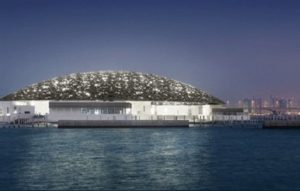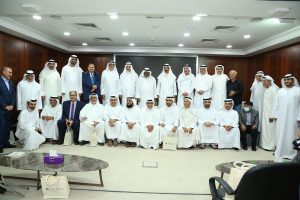Thanks to a series of carefully curated exhibitions at major institutions throughout London this summer, the British capital is as good a place as any from which to assess the recent past and potential future for contemporary culture in the Arab and wider Muslim world.
While the Design Museum is hosting a show dedicated to the work of the Tunisian couturier Azzedine Alaia, the work of the eight shortlisted finalists for the fifth Jameel Prize can be seen on display at the Victoria and Albert Museum.
At the other end of Exhibition Road a 20-metre-tall pyramid, The London Mastaba, floats improbably on the Serpentine, the star exhibit in a show that chronicles Christo’s unrequited, four-decade-long love affair with Abu Dhabi, where the 83-year-old artist still hopes to build the largest sculpture in the world.
At the other end of the scale, a display of newly acquired and very mundane objects – a milk bottle, magazines, cigarette packages, a banknote and a vinyl record – strikes just the right note at the British Museum. They are used alongside a video installation by the artist Maha Maamoun in her exhibition ‘The Past is Present: becoming Egyptian in the 20th Century’ to investigate the interplay between ancient heritage and modern Egyptian identities.
And yet it is another modestly-sized show that also aims to bring something of Cairo to London that takes the prize for the exhibition with the best sense of timing.
Staged at The Mosaic Rooms, ‘What do you mean, here we are?’ commemorates the 20th anniversary of Cairo’s famous Townhouse Gallery and is also part of a series of exhibitions mounted to celebrate The Mosaic Rooms’ tenth anniversary.
The show’s title refers to the Townhouse’s unlikely location, a scruffy neighbourhood in Downtown Cairo, not far from the Nile and the Egyptian Museum, defined by mechanic’s workshops and garages, coffee shops and dilapidated building such as the Townhouse HQ, 10 Nabrawy Street.
“It’s a very busy and very noisy neighbourhood,” explains the show’s co-curator Fiona Fox, who also served as Townhouse’s head of development between 2007 and 2009. “And because the Townhouse is right on a narrow lane, there’s a very direct relationship between it and the people who live and work there. It never had that normal ‘this is a gallery space’ feeling about it at all, which has informed almost everything the gallery has gone on to do.”
Founded by the Canadian cultural entrepreneur William Wells, Townhouse was established as Egypt’s first independent contemporary art space in 1998, a non-profit that has not only been responsible for hosting landmark exhibitions by artists such as Mona Hatoum and Susan Hefuna, but for professional and community workshops, international symposia, artist’s studios and residencies.
“In 2009 and 2010, there were a lot of really important sessions around curatorial practise taken by people who have since gone on to become really successful curators,” Fox explains.
Such is the organisation’s reputation in the Middle East that it now stands as an inspirational reference in a region increasingly defined by new museums and cultural institutions, but even as recently as a year ago, its future was far from certain. In April 2016, one corner of the Nabrawy building collapsed, and three days later police announced that the entire building would soon be demolished.
In the face of community opposition and a stand-off between the building’s tenants and the police, volunteers answered a call on social media to assist the Townhouse team with the removal of the organisation’s archive, which forms the basis of ‘What do you mean, here we are?’, as well as its library and offices to a nearby property.
The efforts of the local community paid off; the Nabrawy building was saved and a specialist committee declared the building safe and approved its restoration.
Since then, the Townhouse and the building’s other tenants have embarked on a long process of reconstruction, and in April 2018, the gallery reopened with an exhibition, Malak Yacout’s Dialogue with 10 Nabrawy – that finally confirmed both the building and the institution’s survival.
“It’s really important to prove that we are still up and running, and we’ve tried to do that in Cairo,” explains Mariam Elnozahy, who as well as acting as Townhouse’s programme manager for the past two years, also co-curated the current exhibition. “A lot of people still think that we are closed, but because Townhouse is held an important role on the international stage over the past 20 years, it was really important to prove that elsewhere, but even when we started working on this show, nothing was certain except for this exhibition.”
One of Elnozahy’s other roles has been to reorganise the Townhouse’s chaotic archive and to kick-start the process of its digitisation, a three-year-long project that’s designed to provide the public with access to the material.
“This exhibition has served as a way for us to take stock, because we are at a turning point where, as a space, we have to look different as a matter of necessity,” says Elnozahy.
“We have had to reconfigure because the community and the society’s needs are different and people now have a different relationship to independent arts spaces.”
In curating the show, one of the main challenges facing Elnozahy and Fox has been to try and make the Townhouse story intelligible to a Western audience while avoiding stereotypes and cliches.
“I’m very conscious of the way Middle Eastern and especially Egyptian art is read in the West or in non-local contexts,” Elnozahy says. “There are lots of tropes about what art looks like under authoritarian regimes or in oppressive political situations and in my experience this has hurt and hindered artists.”
‘What do you mean, here we are?’ succeeds in capturing something of the Townhouse’s profoundly chaotic, carnivalesque vitality by mooring a small piece of Cairo on the banks of the river Thames.
Incomplete it may be, but in many ways that is precisely the point as this is the opening gambit in a yet-to-be-written and very different art and institutional history.
www.thenational.ae




